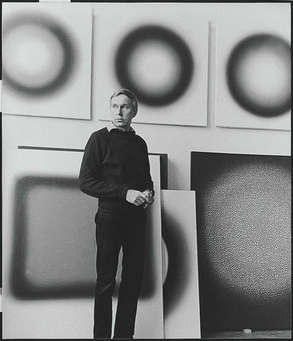Fangor, Wojciech, 1922-2015
Enlarge text Shrink text- Fangor, 1965:cover (Fangor) bio (Wojciech Fangor, b. 11/15/22, Warsaw, Poland)
- LC database, 6/1/95(hdg.: Fangor, Wojciech, 1922- ) ( (Record enhanced with data from: The IMAGINE Thesaurus - The Israel Museum Jerusalem Thesaurus - Artist names authority file) )
Wojciech Bonawentura Fangor (pronounced: VOY-tche-kh ) (15 November 1922 – 25 October 2015), also known as Voy Fangor, was a Polish painter, graphic artist, and sculptor. Described as "one of the most distinctive painters to emerge from postwar Poland", Fangor has been associated with Op art and Color field movements and recognized as a key figure in the history of Polish postwar abstract art. As a graphic artist, Fangor is known as a co-creator of the Polish School of Posters. Between 1953 and 1961, he designed over one hundred posters working alongside Henryk Tomaszewski and Jan Lenica, among others. As a painter, Fangor was trained by the Polish academic and figurative artist Felicjan Szczęsny-Kowarski. After briefly conforming to the style of Socialist Realism during the Stalinist regime in Poland, Fangor had moved toward non-objective painting by the late 1950s. Fangor's 1958 exhibition titled Studium Przestrzeni at Salon Nowej Kultury in Warsaw, organized together with artist and scenographer Stanisław Zamecznik, sought to incorporate Fangor's abstract paintings into the surrounding environment, becoming the foundation for his subsequent experiments with the spatial dimension of color. In 1966, following a period of extensive international travel, Fangor relocated to the United States where he achieved a level of commercial success, critical reception, and direct exposure to American post-war visual culture largely inaccessible to most contemporary artists from the Eastern Bloc. In 1970, he became the first Polish artist to hold a solo exhibition at the Solomon R. Guggenheim Museum in New York. Fangor returned to Poland in 1999 where he remained active until his death in 2015, although his international recognition had by then diminished. For his contributions to the Polish culture, Fangor was awarded several honors, including the Order of Polonia Restituta in 2001, the country's second highest civilian order, and the Gold Medal for Merit to Culture in 2004. His works are included in the permanent collections of museums in Europe, North America, and the Middle East.
Read more on Wikipedia >
 Personality
Personality














